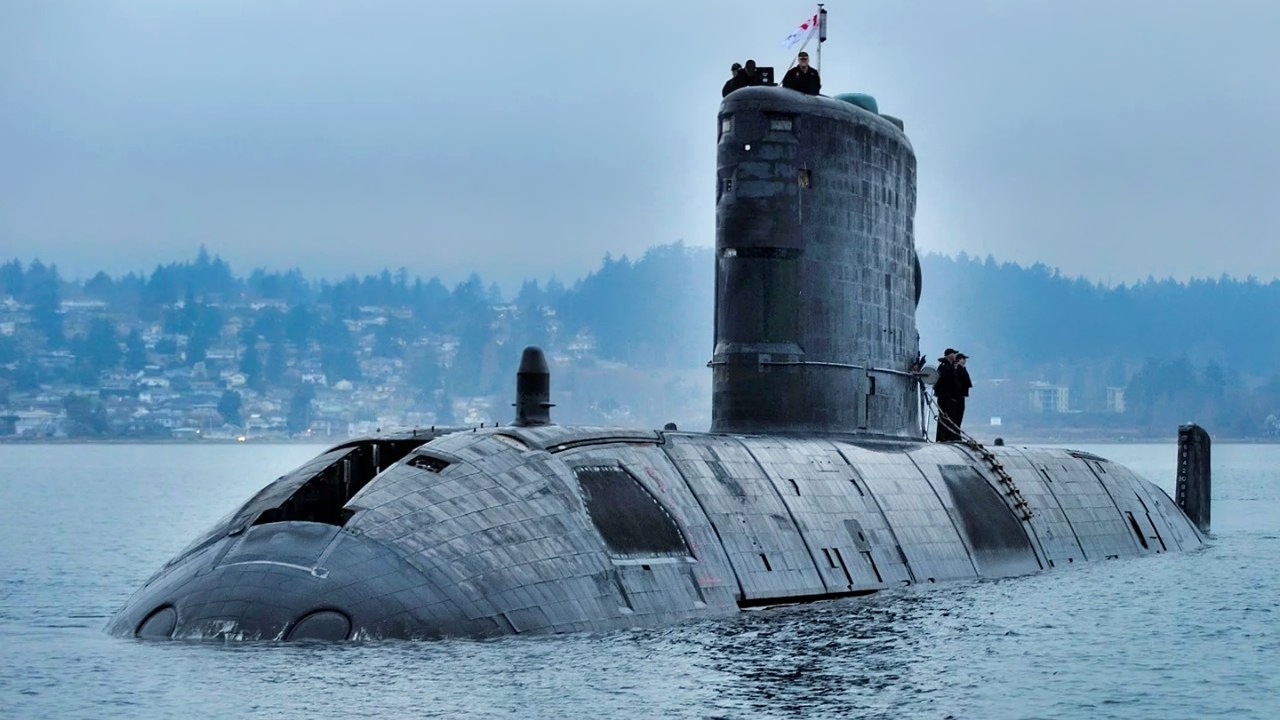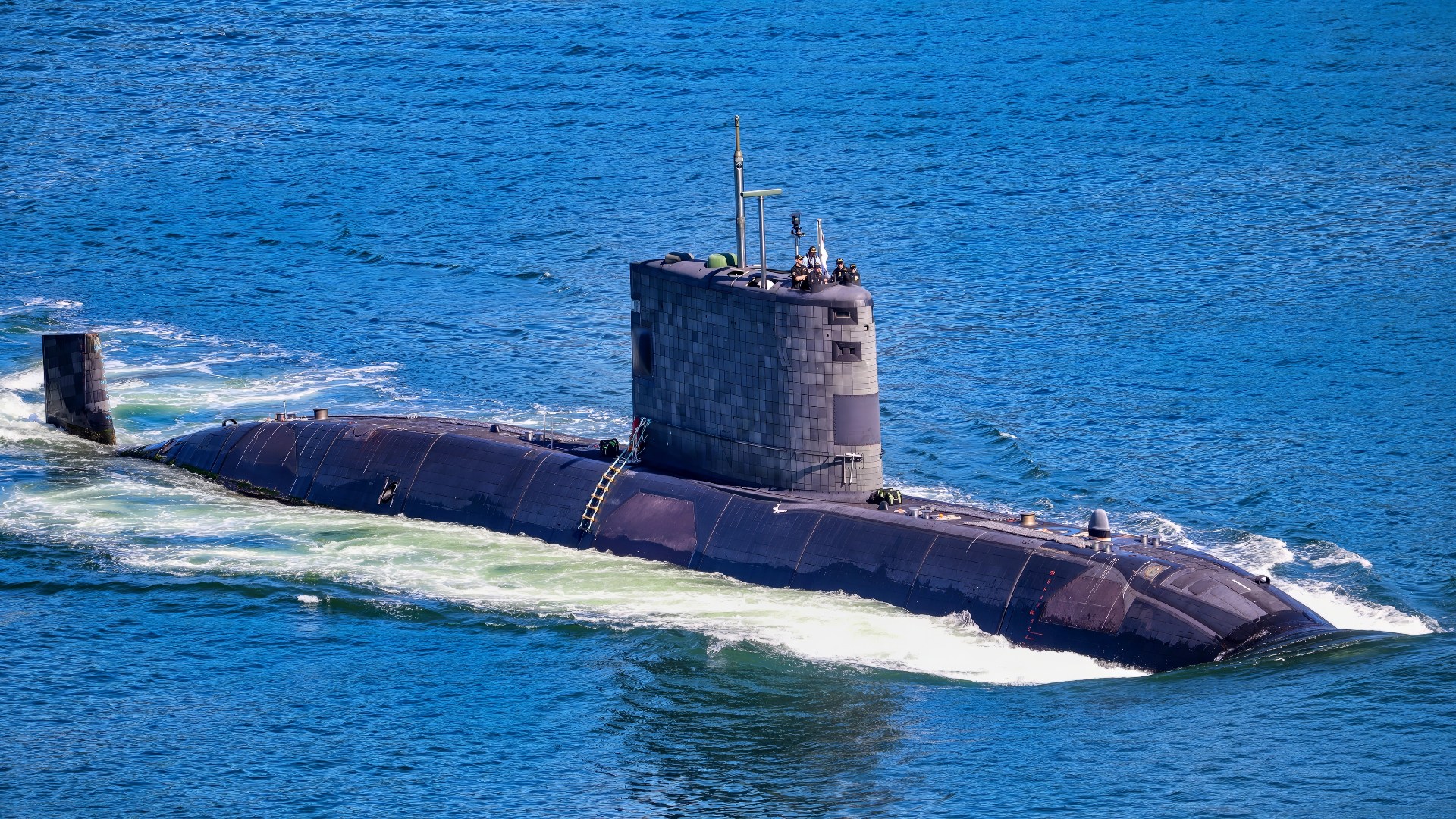Key Points and Summary – Canada’s four aging Victoria-class diesel submarines are costly to maintain and nearing the end of service, spurring the Canadian Patrol Submarine Project to acquire 12 modern conventionally powered boats capable of prolonged under-ice operations.
-Ottawa shortlisted Germany’s ThyssenKrupp Marine Systems and South Korea’s Hanwha as qualified suppliers, aiming for NATO interoperability, Arctic deterrence, and roles spanning ASW, ISR, and special operations support.

The Royal Canadian Navy long-range patrol submarine HMCS Victoria (SSK 876) arrives at Naval Base Kitsap-Bangor for a port call and routine maintenance. The visit is Victoria’s first to Bangor since 2004. (U.S. Navy photo by Lt. Ed Early/Released)

Victoria-Class Submarine Canada Navy. Image Credit: Creative Commons.
-Past mishaps underscore urgency, yet timelines suggest first deliveries in the early 2030s, raising readiness concerns.
-Success hinges on avoiding delays and cost overruns while integrating quieting, endurance, and maneuverability to safeguard sovereignty across the world’s longest coastline.
Victoria-Class Replacement: Canada May Not Get New Submarines Until the Early 2030s
Canada has a significant amount of coastline that its navy struggles to police. It has the longest coastline in the world, spanning 125,567 miles. This encompasses the Atlantic, Pacific, and Arctic Oceans, as well as numerous islands.
The country depends on submarines to protect its sovereignty and patrol its borders. Its submarines are getting old, though, and are approaching the end of their service life. The Victoria-class boats must be replaced with modern vessels that can patrol under the ice for long periods.
Canada has geopolitical concerns, as several countries are attempting to dominate the Arctic Ocean through territorial declarations that Canada must challenge in the region. Russia and China are flexing their muscles in this area, and Canada must keep pace. The Great White North needs to be first in this competition to dominate in its sphere of influence. Submarines are integral to the doctrine and defense strategy for deterrence in the Arctic, as well as maintaining open sea lanes and ensuring free navigation of the waters. But it’s time for new ones.
The Current Victoria-class Subs Are Not Sufficient
Canada only has four diesel-powered submarines. These are known as the Victoria-class. These subs began their careers under the United Kingdom’s flag. When the British Royal Navy removed them from service in 1994, they were sold to Canada for $750 million to replace the Oberon-class submarines, which were finally retired in 1998.
Victoria-class subs are 230 feet long. They displace 2,200 tons when surfaced and 2,450 tons when diving. The top speed is only 12 knots on the surface and 20 knots underwater. They can stay out on patrol for only eight weeks. There are 48 sailors on board.
There Have Been Problematic Periods in the Victoria-class Experience
The service record for the Victoria-class has been mixed. The Chicoutimi once had a fire in 2004 during its maiden voyage from the United Kingdom to Canada, resulting in the death of one sailor and the wounding of two others. The Corner Brook hit the floor of the ocean off British Columbia in 2011. Two sailors were seriously hurt. The submarine was able to make it back to the surface and head for home, but the damage was severe.
The most successful deployment of the Victoria-class was when the Chicoutimi sailed to Japan after a six-month voyage in 2017. This demonstrated that the Victoria-class could undertake worldwide journeys and put a feather in the cap of the Canadian Navy. Ottawa believed that the problems and bad luck the boats had experienced were mitigated and that they could protect Canadian shores from future incidents. The Navy decided to extend the life cycle of the program by another eight years in 2017.
Naval Doctrine Relies Greatly on Undersea Warfare
However, Canada knew that a day would come when the old boats would need to be retired. The navy fashioned a program called the Canadian Patrol Submarine Project. This would examine needs and use cases for improving undersea warfare tactics, operations, and strategy, and create standards required to accomplish subsea objectives.
The Canadian military determined that it needed 12 new conventionally powered submarines after studying the ways and means for the Canadian Patrol Submarine Project.
These needed to be able to operate under ice for long periods and possess the lethality, stealthiness, speed, and diving ability to deter other nations’ submarines that were patrolling close to Canadian shores.
Two Maritime Defense Contractors Have Been Selected
The government announced in August that the “German company Thyssen Krupp Marine Systems (TKMS) and Korean company Hanwha Ocean Co., Ltd. (Hanwha) were the two qualified suppliers for the Canadian Patrol Submarine Project (CPSP).”
Canada aims for its submarines to be interoperable with NATO powers as it examines its long-term goals in the Arctic, particularly given Russia and China’s interests in the region.
“The Canadian Patrol Submarine Project will safeguard Canada’s sovereignty and strengthen partnerships with our allies by delivering next-generation submarines to the Royal Canadian Navy. The advanced submarines will give our Navy the confidence and capabilities to respond effectively to emerging threats. At the same time, creating opportunities for Canadian industry and identifying TKMS and Hanwha as the qualified suppliers marks an important step toward the procurement of this critical capability,” according to Stephen Fuhr, the Secretary of State for Defense Procurement.
Can All of the New Submarine Requirements Be Met?
The existing Victoria-class ships are becoming increasingly complex and expensive to maintain due to their older systems, which date back to their service with Great Britain. The problem is that the Victoria-class modernization program has been delayed over the years, and it has taken until 2025 to get the two defense contractors in line.
The new submarines must be able to operate in both shallow and deeper waters, and be quiet, agile, and maneuverable. The subs need the capacity to engage in anti-submarine warfare, collect intelligence and reconnaissance data, and infiltrate and exfiltrate special operations forces.
It remains to be seen whether the German and South Korean defense contractors can meet all of those needs. South Korea is accustomed to its submarines sailing in warmer waters, and Germany lacks the coastline that Canada has.
The new submarines are likely to be ready by the early 2030s. This is a disappointment for the Canadian Navy, which would like to replace the Victoria-class as soon as possible. However, the extra time spent on construction will enable the maritime branch to incorporate all the necessary features to serve such a long coastline and compete with the navies of rival nations.
However, the military is aware of the high stakes and recognizes that there can be no new delays or cost overruns. It is also good news that the army has an agreed-upon strategy and that many government representatives are on board with acquiring new submarines. Sometimes being aware of a defense shortcoming is half the battle. Canada will eventually have new subs, and that will be a welcome development. This situation is not yet in a crisis stage, but it is a significant concern that could escalate into a crisis if the 12 new subs are not operational by 2035.
About the Author: Brent M. Eastwood
Brent M. Eastwood, PhD is the author of Don’t Turn Your Back On the World: a Conservative Foreign Policy and Humans, Machines, and Data: Future Trends in Warfare plus two other books. Brent was the founder and CEO of a tech firm that predicted world events using artificial intelligence. He served as a legislative fellow for US Senator Tim Scott and advised the senator on defense and foreign policy issues. He has taught at American University, George Washington University, and George Mason University. Brent is a former US Army Infantry officer. He can be followed on X @BMEastwood.
More Military
The U.S. Navy’s Great Ford-Class Aircraft Carrier Reboot Has Arrived
The U.S. Navy’s Great Iowa-Class Battleship Reboot
Is the Ukraine War ‘Shapeshifting’ Into the Vietnam War?
China’s Great J-20 Mighty Dragon Stealth Fighter Reboot Has Arrived










